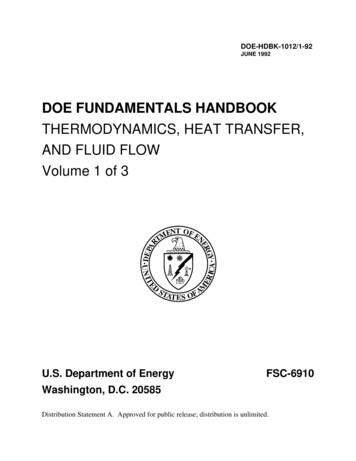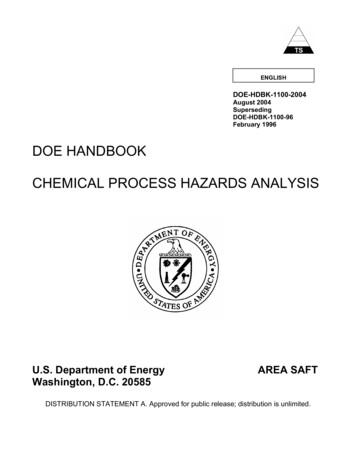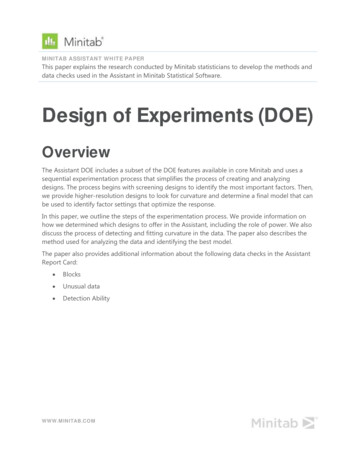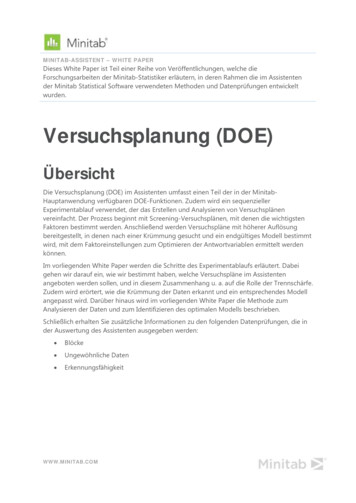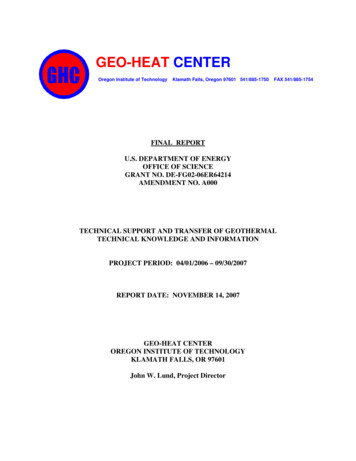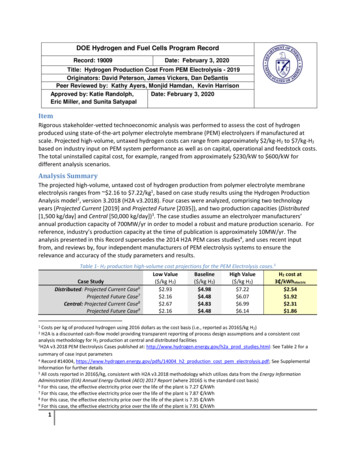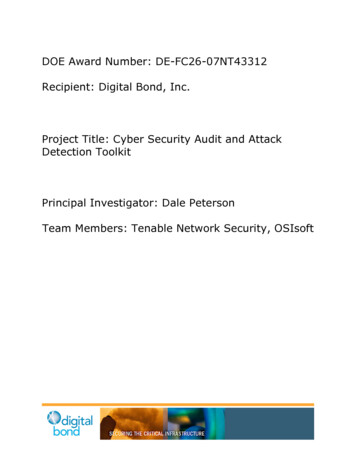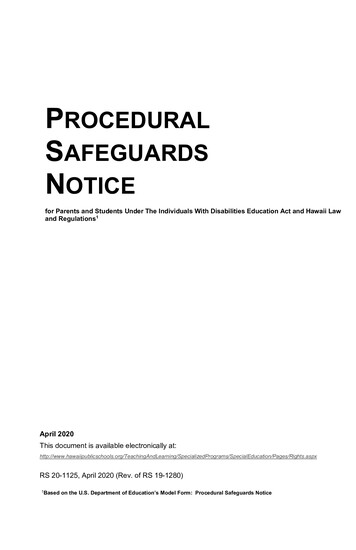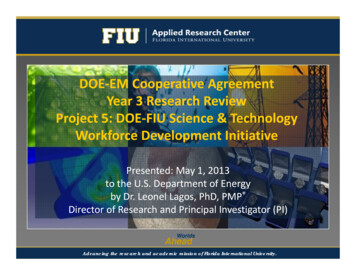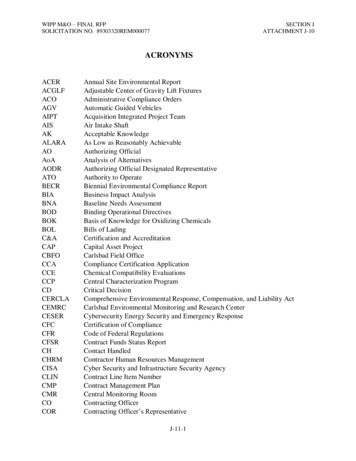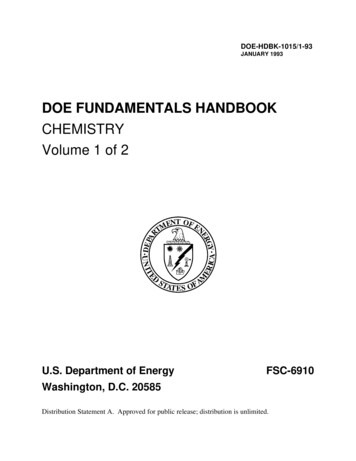
Transcription
DOE-HDBK-1015/1-93JANUARY 1993DOE FUNDAMENTALS HANDBOOKCHEMISTRYVolume 1 of 2U.S. Department of EnergyFSC-6910Washington, D.C. 20585Distribution Statement A. Approved for public release; distribution is unlimited.
This document has been reproduced directly from the best available copy.Available to DOE and DOE contractors from the Office of Scientific andTechnical Information. P.O. Box 62, Oak Ridge, TN 37831; prices availablefrom (615) 576-8401.Available to the public from the National Technical Information Services, U.S.Department of Commerce, 5285 Port Royal., Springfield, VA 22161.Order No. DE93011966
DOE-HDBK-1015/1-93CHEMISTRYABSTRACTThe Chemistry Handbook was developed to assist nuclear facility operating contractorsin providing operators, maintenance personnel, and the technical staff with the necessaryfundamentals training to ensure a basic understanding of chemistry. The handbook includesinformation on the atomic structure of matter; chemical bonding; chemical equations; chemicalinteractions involved with corrosion processes; water chemistry control, including the principlesof water treatment; the hazards of chemicals and gases, and basic gaseous diffusion processes.This information will provide personnel with a foundation for understanding the chemicalproperties of materials and the way these properties can impose limitations on the operation ofequipment and systems.Key Words: Training Material, Atomic Structure of Matter, The Periodic Table of theElements, Chemical Bonding, Corrosion, Water Chemistry Control, Water Treatment Principles,Chemical Hazards, Gaseous Diffusion ProcessesRev. 0CH
DOE-HDBK-1015/1-93CHEMISTRYFOREWORDThe Department of Energy (DOE) Fundamentals Handbooks consist of ten academicsubjects, which include Mathematics; Classical Physics; Thermodynamics, Heat Transfer, andFluid Flow; Instrumentation and Control; Electrical Science; Material Science; MechanicalScience; Chemistry; Engineering Symbology, Prints, and Drawings; and Nuclear Physics andReactor Theory. The handbooks are provided as an aid to DOE nuclear facility contractors.These handbooks were first published as Reactor Operator Fundamentals Manuals in 1985for use by DOE category A reactors. The subject areas, subject matter content, and level ofdetail of the Reactor Operator Fundamentals Manuals were determined from several sources.DOE Category A reactor training managers determined which materials should be included, andserved as a primary reference in the initial development phase. Training guidelines from thecommercial nuclear power industry, results of job and task analyses, and independent input fromcontractors and operations-oriented personnel were all considered and included to some degreein developing the text material and learning objectives.The DOE Fundamentals Handbooks represent the needs of various DOE nuclear facilities’fundamental training requirements. To increase their applicability to nonreactor nuclear facilities,the Reactor Operator Fundamentals Manual learning objectives were distributed to the NuclearFacility Training Coordination Program Steering Committee for review and comment. To updatetheir reactor-specific content, DOE Category A reactor training managers also reviewed andcommented on the content. On the basis of feedback from these sources, information that appliedto two or more DOE nuclear facilities was considered generic and was included. The final draftof each of the handbooks was then reviewed by these two groups. This approach has resultedin revised modular handbooks that contain sufficient detail such that each facility may adjust thecontent to fit their specific needs.Each handbook contains an abstract, a foreword, an overview, learning objectives, and textmaterial, and is divided into modules so that content and order may be modified by individualDOE contractors to suit their specific training needs. Each handbook is supported by a separateexamination bank with an answer key.The DOE Fundamentals Handbooks have been prepared for the Assistant Secretary forNuclear Energy, Office of Nuclear Safety Policy and Standards, by the DOE TrainingCoordination Program. This program is managed by EG&G Idaho, Inc.Rev. 0CH
DOE-HDBK-1015/1-93CHEMISTRYOVERVIEWThe Department of Energy Fundamentals Handbook entitled Chemistry was prepared asan information resource for personnel who are responsible for the operation of the Department’snuclear facilities. An understanding of chemistry will enable contractor personnel to understandthe intent of the chemical concerns within their facility. A basic understanding of chemistry isnecessary for DOE nuclear facility operators, maintenance personnel, and the technical staff tosafely operate and maintain the facility and facility support systems. The information in thehandbook is presented to provide a foundation for applying engineering concepts to the job. Thisknowledge will help personnel understand the impact that their actions may have on the safe andreliable operation of facility components and systems.The Chemistry handbook consists of five modules that are contained in two volumes. Thefollowing is a brief description of the information presented in each module of the handbook.Volume 1 of 2Module 1 - Fundamentals of ChemistryIntroduces concepts on the atomic structure of matter. Discusses the periodic tableand the significance of the information in a periodic table. Explains chemicalbonding, the laws of chemistry, and chemical equations.Appendix A - Basic Separation TheoryIntroduces basic separation theory for the gaseous diffusion process.Discusses converter construction and basic operating principals.Module 2 - CorrosionSupplies basic information on the chemical interaction taking place during thecorrosion process between the environment and the corroding metal.Rev. 0CH
DOE-HDBK-1015/1-93CHEMISTRYOVERVIEW (Cont.)Volume 2 of 2Module 3 - Reactor Water ChemistryDescribes the chemical measures taken to retard the corrosion often found in watersystems. The consequences of radioactivity on facility cooling water systems arealso addressed.Module 4 - Principles of Water TreatmentDetails the principles of ion exchange in the context of water purity. Discussestypical water treatment methods and the basis for these methods.Module 5 - Hazards of Chemicals and GasesExplains why certain chemicals are considered hazardous to facility personnel.Includes general safety rules on handling and storage.The information contained in this handbook is by no means all encompassing. An attemptto present the entire subject of chemistry would be impractical. However, the ChemistryHandbook does present enough information to provide the reader with a fundamental knowledgelevel sufficient to understand the advanced theoretical concepts presented in other subject areas,and to better understand basic system and equipment operation.Rev. 0CH
Department of EnergyFundamentals HandbookCHEMISTRYModule 1Fundamentals of Chemistry
Fundamentals of ChemistryDOE-HDBK-1015/1-93TABLE OF CONTENTSTABLE OF CONTENTSLIST OF FIGURES . . . . . . . . . . . . . . . . . . . . . . . . . . . . . . . . . . . . . . . . . . . . . . . . . . ivLIST OF TABLES . . . . . . . . . . . . . . . . . . . . . . . . . . . . . . . . . . . . . . . . . . . . . . . . . . . vREFERENCES . . . . . . . . . . . . . . . . . . . . . . . . . . . . . . . . . . . . . . . . . . . . . . . . . . . .viOBJECTIVES . . . . . . . . . . . . . . . . . . . . . . . . . . . . . . . . . . . . . . . . . . . . . . . . . . . . . viiCHARACTERISTICS OF ATOMS . . . . . . . . . . . . . . . . . . . . . . . . . . . . . . . . . . . . . .Characteristics of MatterThe Atom Structure . . .Chemical Elements . . .Molecules . . . . . . . . . .Avogadro’s Number . . .The Mole . . . . . . . . . .Mole of Molecules . . . .Summary . . . . . . . . . .1. 1. 2. 3. 7. 8. 9. 10. 11THE PERIODIC TABLE . . . . . . . . . . . . . . . . . . . . . . . . . . . . . . . . . . . . . . . . . . . . . 12Periodic Table . . . . . . . . . . .Classes of the Periodic TableGroup Characteristics . . . . . .Atomic Structure of ElectronsSummary . . . . . . . . . . . . . .1216181922CHEMICAL BONDING . . . . . . . . . . . . . . . . . . . . . . . . . . . . . . . . . . . . . . . . . . . . . . 23Chemical Bonding . . .Ionic Bonds . . . . . . .Covalent Bonds . . . . .Metallic Bonds . . . . .Van der Waals ForcesOrganic Chemistry . . .Alkanes . . . . . . . . . .Alkenes . . . . . . . . . .Alkynes . . . . . . . . . .Rev. 0.Page i.232425272728282930CH-01
TABLE OF CONTENTSDOE-HDBK-1015/1-93Fundamentals of ChemistryTABLE OF CONTENTS (Cont.)Aromatics . . . . . . . . . . . . . . .Alcohols . . . . . . . . . . . . . . . .Aldehydes . . . . . . . . . . . . . .Basic Chemical Laws . . . . . . .Forming Chemical CompoundsCombining Elements . . . . . . .Summary . . . . . . . . . . . . . . .30303131323334CHEMICAL EQUATIONS . . . . . . . . . . . . . . . . . . . . . . . . . . . . . . . . . . . . . . . . . . . . 36Le Chatelier’s Principle . . . . .Density . . . . . . . . . . . . . . . .Molarity . . . . . . . . . . . . . . . .Normality . . . . . . . . . . . . . . .Parts per Million . . . . . . . . . .Chemical Equations . . . . . . . .Balancing Chemical EquationsSummary . . . . . . . . . . . . . . .3637373839404045ACIDS, BASES, SALTS, AND pH . . . . . . . . . . . . . . . . . . . . . . . . . . . . . . . . . . . . . . 46Acids . . . . . . . . . . .Bases . . . . . . . . . . .Salts . . . . . . . . . . .pH . . . . . . . . . . . . .pOH . . . . . . . . . . .Dissociation ConstantSummary . . . . . . . .46474848495053APPENDIX A BASIC SEPARATION THEORY . . . . . . . . . . . . . . . . . . . . . . . . . . . A-1Introduction . . . . . . .Isotopic Separation . .Separation Factor . . . .Stage Separation . . . .Barrier MeasurementsCascade Theory . . . . .Circuit Balance . . . . .CH-01.Page ii.A-1A-1. A-2A-2. A-5A-6. A-7Rev. 0
Fundamentals of ChemistryDOE-HDBK-1015/1-93TABLE OF CONTENTSTABLE OF CONTENTS (Cont.)CONVERTERS . . . . . . . . . . . . . . . . . . . . . . . . . . . . . . . . . . . . . . . . . . . . . . . . . .Converters . . . . . . . .Converter ConstructionThe Gas Cooler . . . . .Barrier Tubing . . . . .Process Gas Flow . . .Diffusion . . . . . . . . .Rev. 0.Page iii.A-10. A-10. A-10. . A-12. A-12. . A-12. A-13CH-01
LIST OF FIGURESDOE-HDBK-1015/1-93Fundamentals of ChemistryLIST OF FIGURESFigure 1 Schematic of a Simple Atom (Helium) . . . . . . . . . . . . . . . . . . . . . . . . . . . . . . 2Figure 2 A Mole of Gold Compared to a Mole of Copper . . . . . . . . . . . . . . . . . . . . . . . 9Figure 3 Periodic Table of the Elements . . . . . . . . . . . . . . . . . . . . . . . . . . . . . . . . . . 15Figure 4 Regional Schematic of Periodic Table . . . . . . . . . . . . . . . . . . . . . . . . . . . . . 16Figure 5 Electron Shells of Atoms . . . . . . . . . . . . . . . . . . . . . . . . . . . . . . . . . . . . . . 19Figure 6 Ionic Bond, Sodium Chloride . . . . . . . . . . . . . . . . . . . . . . . . . . . . . . . . . . . 24Figure 7 Covalent Bond, Methane CH4 . . . . . . . . . . . . . . . . . . . . . . . . . . . . . . . . . . . 25Figure 8 Formation of the Carbon Dioxide Molecule . . . . . . . . . . . . . . . . . . . . . . . . . 26Figure 9 Coordinate Covalent Bond, Chlorate Ion ClO3 . . . . . . . . . . . . . . . . . . . . . . . . 26Figure 10 Van der Waals Forces . . . . . . . . . . . . . . . . . . . . . . . . . . . . . . . . . . . . . . . 28Figure 11 Alkane . . . . . . . . . . . . . . . . . . . . . . . . . . . . . . . . . . . . . . . . . . . . . . . . . . 29Figure 12 Alkene . . . . . . . . . . . . . . . . . . . . . . . . . . . . . . . . . . . . . . . . . . . . . . . . . . 29Figure 13 Alkyne . . . . . . . . . . . . . . . . . . . . . . .
Module 3 - Reactor Water Chemistry Describes the chemical measures taken to retard the corrosion often found in water systems. The consequences of radioactivity on facility cooling water systems are also addressed. Module 4 - Principles of Water Treatment Details the principles of ion exchange in the context of water purity. Discusses typical water treatment methods and the basis for these .
